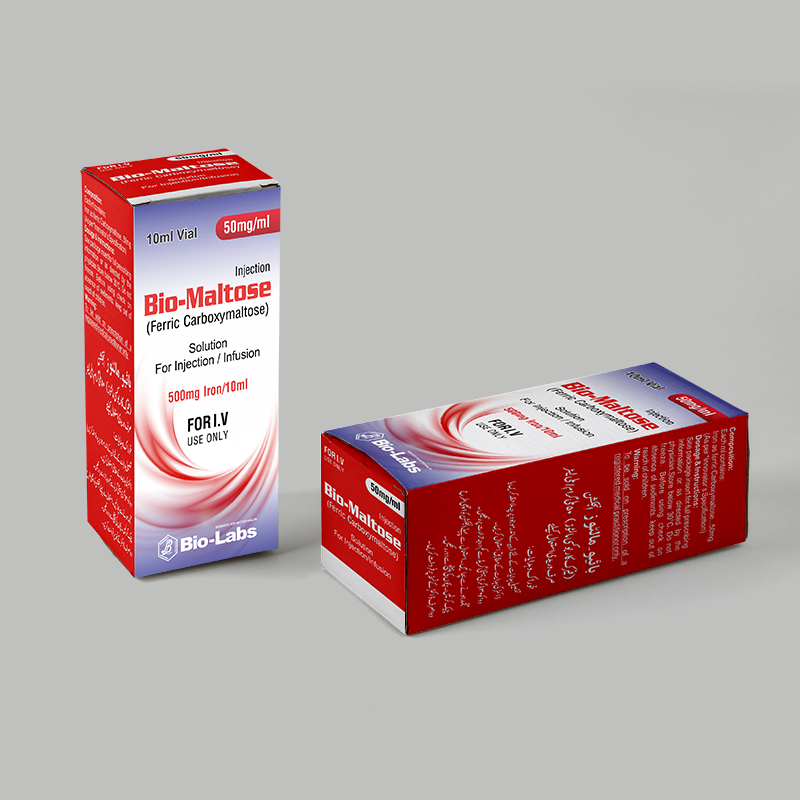
Each Vial Contains
Each ml contains: Iron as Ferric Carboxymaltose
Ferric Carboxymaltose 500mg/10ml
Ferric carboxymaltose is a macromolecular ferric hydroxide carbohydrate complex that allows the controlled delivery of iron within the cells of the reticuloendothelial system and delivers subsequently to the transferrin and ferritin – the iron-binding proteins, with the lesser risk of releasing a large quantity of ionic iron in the serum.
Bio-Maltose is indicated for the treatment of iron deficiency when;
– Oral iron preparations are ineffective.
– Oral iron preparations cannot be used.
– There is a clinical need to deliver iron rapidly.
The diagnosis of iron deficiency must be based on laboratory tests.
Bio-Maltose should only be administered when staff trained to evaluate and manage anaphylactic reactions is immediately available, in an environment where full resuscitation facilities can be assured. The patient should be observed for adverse effects for at least 30 minutes following each Bio-Maltose administration.
Follow the step-wise approach
The individual iron need for repletion using Bio-Maltose is determined based on the patient’s body weight and haemoglobin (Hb) level.
| Hb | Patient body weight | |||
| g/dL | mmol/L | below 35 kg | 35 kg to <70 kg | 70 kg and above |
| <10 | <6.2 | 500 mg | 1,500 mg | 2,000 mg |
| 10 to <14 | 6.2 to <8.7 | 500 mg | 1,000 mg | 1,500 mg |
| ≥14 | ≥8.7 | 500 mg | 500 mg | 500 mg |
Based on the iron need determined above, the appropriate dose(s) of Bio-Maltose should be administered taking into consideration the following:
A single Bio-Maltose administration should not exceed:
The maximum recommended cumulative dose of Bio-Maltose is 1,000 mg of iron (20 mL Bio-Maltose) per week.
The clinician should perform a re-assessment based on the individual patient’s condition. The Hemoglobin level should be re-assessed no earlier than four weeks post final Bio-Maltose administration to allow adequate time for erythropoiesis and iron utilisation. If the patient requires further iron repletion, the iron need should be recalculated.
Hypersensitivity reactions
Parenterally administered iron preparations can cause hypersensitivity reactions including serious and potentially fatal anaphylactic/anaphylactoid reactions. Hypersensitivity reactions have also been reported after previously uneventful doses of parenteral iron complexes.
The risk is enhanced for patients with known allergies, including drug allergies, including patients with a history of severe asthma, eczema, or other atopic allergies.
Risks are higher for patients with Rheumatoid Arthritis and systemic lupus erythematosus.
In patients with liver dysfunction, parenteral iron should only be administered after careful benefit/risk assessment. Parenteral iron administration should be avoided in patients with hepatic dysfunction where iron overload is a precipitating factor, in particular Porphyria Cutanea Tarda (PCT). Careful monitoring of iron status is recommended to avoid iron overload.
No safety data on hemodialysis-dependent chronic kidney disease patients receiving single doses of more than 200 mg iron are available.
Parenteral iron must be used with caution in case of acute or chronic infection, asthma, eczema, or atopic allergies. It is recommended that the treatment with Bio-Maltose be stopped in patients with ongoing bacteremia. Therefore, a benefit/risk evaluation has to be performed in patients with chronic infection, taking into account the suppression of erythropoiesis.
The use of Bio-Maltose has not been studied in children.